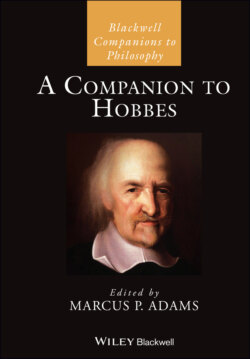Читать книгу A Companion to Hobbes - Группа авторов - Страница 39
2.2.4 God
ОглавлениеSince Hobbes was avowedly both a theist and a materialist, his God must be some sort of body. As noted above, he says so much in a brief dialogue appended to the Latin edition of Leviathan (1668), where Hobbes’s mouthpiece “B” brashly “affirms, of course, that God is body.”19 Concurrently, his longtime intellectual frenemy, Anglican Bishop John Bramhall, pressed Hobbes on the same question: since Hobbes considers “incorporeal substance” contradictory, Bramhall asks, what then does he “leave God himself to be?” (1842–1844, IV.525). Hobbes pulls no punches: “I leave him to be a most pure, simple, invisible spirit corporeal” (EW IV.313).20 In recent scholarship, this late confession of corporeal theism has generally been dismissed as either atheistic dissimulation or a clumsy statement of sincere of Calvinist minimalism.21 This is understandable. After all, taken on its face, where could Hobbes have obtained such an idea?22 The answer is: from classical Stoicism.
Consider two passages. The first is Diogenes Laertius’ gloss of the role of God in Stoic physics:
They believe there are two principles of the universe, the active and the passive. The passive is unqualified substance, i.e., matter, the active is the rational principle (logos) in it. i.e., God … In the beginning he was by himself and turned all substances into water via air and just as the seed is contained in the seminal fluid so this being the spermatic principle of the cosmos remains like this in the cosmos and makes the matter easy for itself to work with in the generation of subsequent things.
(Diogenes Laertius Lives of the Philosophers Bk. 7, 134; LS 1987, 268–9, 275)23
The second is Hobbes’s (1662) account of his corporeal God’s operation in the world:
I have seen, and so have many others, two waters, one of the river and the other mineral water, so that no man could discern one from the other from his sight; yet when they are both put together the whole substance could not be distinguished from milk. How then could the change be made in every part, but only by the activity of the mineral water, changing it everywhere to the sense and yet not being everywhere and in every part of the water. If such gross bodies have such great activity what then can we think of spirits, whose kinds be as many as there are kinds of liquor, and activity greater? Can it then be doubted that God, who is infinitely fine spirit, and withal intelligence, can make and change all species and kinds of bodies as he pleaseth?
(EW IV.310)
The parallels between these passages are striking: (i) each makes God a special kind of corporeal substance that produces the diversity among familiar bodies by acting on passive and homogenous matter; (ii) each says the divine body operates by thoroughly pervading ordinary matter (though Hobbes denies this involves complete mixing); (iii) each conceives of the divine body as intelligent. I maintain this similarity is no accident: Hobbes adapted his corporeal God from Stoic sources.
Two aspects of the parallel are worth emphasizing. First, consistent with tradition, Hobbes and the Stoics both trace the source of change and diversity to the continuous and ubiquitous activity of God on something like prime matter (OL I.105; EW I.118).24 However, departing radically from tradition, they both hold that God acts on matter by direct contact and local motion. On the Stoics’ biological metaphor, God acts like the seed in seminal fluid; on Hobbes’s chemical metaphor, God is the catalyst in a cosmic cocktail. But in order to avoid a regress, the Stoics and Hobbes both insist that the corporeal God must be in some sense inherently active: a sort of fiery air (pneuma) for the Stoics, an infinitely subtle fluid or spirit for Hobbes (Alexander, on Mixture III, 216, 14–20, T 115, LS 1987, 290; OL I.340; EW I.417). Hobbes signals to Bramhall his debt to the Stoic tradition, on this point, noting that “spirit” in Latin signifies “breadth, air, wind” and “in Greek πνεῦμα (pneuma)” (EW IV.309; see also 2012, 612; 1651, 303).25
A second important parallel is the common fixation on mixing. Hobbes emphasizes that God pervades ordinary matter though it is impossible they fully mix “unless two bodies can be in the same place” (EW IV.309–10). In Stoic physics the admixture of distinct bodies, particularly God and matter, is hotly debated but generally admitted.26 Hobbes embraces the Stoic theology but follows more orthodox thinkers like Aristotle in opposing strict co-location. His opposition to full mixing is based on his austere geometrical or Cartesian view of extension, which makes the co-extension of distinct bodies impossible. What is most noteworthy for us is that Hobbes even bothers to engage this esoteric and antiquated debate about mixing. This betrays his sympathy for the Stoic materialist program, inside and out.27
